As the importance of Urkesh became apparent following two decades of excavations, the various communities around Tell Mozan became more and more aware of the significance of their territorial history. Thus, the Expedition developed plans for the establishment of an Eco-Archaeological Park. After a couple of years' work in cooperation with the competent authorities, a full proposal was drawn up in 2010. The outbreak of the war in 2011 made it impossible to take the necessary legal steps for its implementation. We did, however, pursue our basic intent to protect the countryside originally envisaged for the Park: an area of some 54 km2 with 26 villages.
To this end, we undertook a pilot project, "The modern face of an ancient city," supported by the UCLA Office of the Vice Chancellor for Research under the program Transdisciplinary Seed Grant Forum (see under cycle 1). The project was funded for the two consecutive academic years 2011-12 and 2012-2013. Its aim was to combine archaeology with economics, and was under the direction, respectively, of Giorgio Buccellati (UCLA) and Pasquale Lucio Scandizzo (Università di Roma, Tor Vergata). Prof. Scandizzo had visited Mozan in 2009 together with his collegaue, Prof. Giovanni Tria, also from the Dept. of Economics at Tor Vergata.
This website describes the project undertaken at that time, and the work that has continued since, thus serving as a repository for work in progress. It overlaps in part with data found in the avasa.it website.
|
